British comedian Peter Sellers (1925-1980) was an incredibly versatile actor. He played Chief Inspector Clouseau in the Pink Panther films with as much ease as Clare Quilty in Lolita (1962). Stanley Kubrick asked him to play three roles in Dr. Strangelove (1964) for which he was nominated for an Academy Award.
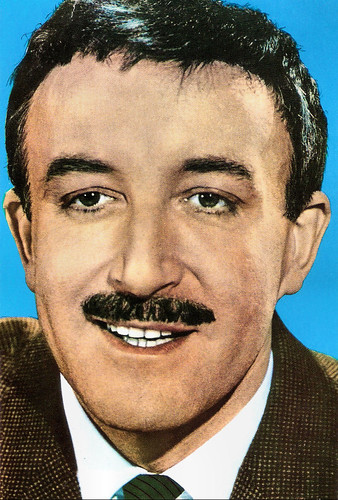
Spanish postcard by Raker no. 1132, 1965.
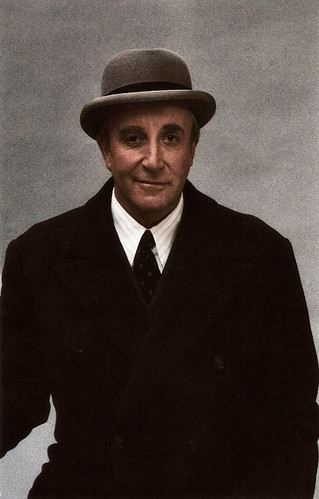
American postcard by Coral-Lee, Rancho Cordova, no. CL/Personality # 95. Photo: Dianne Schroeder / Sygma, 1979. Publicity still for Being There (Hal Ashby, 1979).
Richard Henry Sellers was born in 1925 in Southsea, a suburb of Portsmouth, England. He was literally born into show business. His parents, William 'Bill' Sellers and Agnes Doreen 'Peg' née Marks, were vaudeville performers in an acting company run by his grandmother, and Peter arrived while they were appearing in Southsea. Although christened Richard Henry, his parents called him Peter, after his elder stillborn brother.
Peter made his stage debut at the Kings Theatre, Southsea, when he was two weeks old. Sellers remained an only child. He began accompanying his parents in a variety act that toured the provincial theatres, causing much upheaval and unhappiness in the young Sellers' life. Sellers studied dance as a child before attending St. Aloysius’ Boarding and Day School for Boys.
As a teenager, Sellers learned to play the drums and played with jazz bands. At the age of 18, he entered the Royal Air Force during World War II. There he became part of a group of entertainers who performed for the troops. Sellers played his drums and did dead-on impersonations of some of the officers.
After the war, Sellers struggled to launch his comic career for several years. After several previous attempts, he managed to land work with the British Broadcasting Corporation (BBC) by winning over radio producer Roy Speer during a phone conversation. His spot-on impersonations helped to make him a beloved radio comedian.
In 1951, Sellers joined fellow comics Spike Milligan, Harry Secombe and Michael Bentine for The Goon Show. The program proved to be hugely popular with listeners who tuned in to hear their absurd skits and bits. The success of The Goon Show helped Sellers break into films.
In 1951 the Goons made their feature film debut in Penny Points to Paradise (Anthony Young, 1951). Sellers and Milligan then penned the script to the short Let's Go Crazy (Alan Cullimore, 1951), the earliest film to showcase Sellers's ability to portray a series of different characters within the same film, and he made another appearance opposite his Goons co-stars in the flop, Down Among the Z Men (Maclean Rogers, 1952).
In 1954, Sellers was cast opposite Sid James, Donald Pleasence and Eric Sykes in the comedy Orders Are Orders (David Paltenghi, 1955). Then he landed a part as one of the oddball criminals in the classic Ealing comedy The Ladykillers (Alexander Mackendrick, 1955) with Alec Guinness. The Ladykillers was a success in both Britain and the US, and the film was nominated for an Academy Award for Best Original Screenplay.
Sellers starred with David Tomlinson and Wilfrid Hyde-White as a chief petty officer in Up the Creek (Val Guest, 1958). In 1959, his career really took off with the satire I’m All Right, Jack (John and Roy Boulting, 1959). For his part as Fred Kite, the dogmatic communist union man, he won the BAFTA Award for Best Actor in a Leading Role. In The Mouse That Roared (Jack Arnold, 1959) with Jean Seberg, Sellers played three characters: the elderly Grand Duchess, the ambitious Prime Minister and the innocent and clumsy farm boy selected to lead an invasion of the United States. This box office hit helped to introduce Sellers to the American audiences.
In 1959 he was also nominated for an Academy Award for the eleven-minute short The Running Jumping & Standing Still Film (Richard Lester, Peter Sellers, 1959). Sellers portrayed an Indian doctor, Dr Ahmed el Kabir opposite Sophia Loren in the romantic comedy The Millionairess (Anthony Asquith, 1960) based on the George Bernard Shaw play. The Goon Show ended its run in 1960, but the program proved to be a strong influence on British comedy. It paved the way for such future comedy shows as Monty Python's Flying Circus.

Vintage postcard.
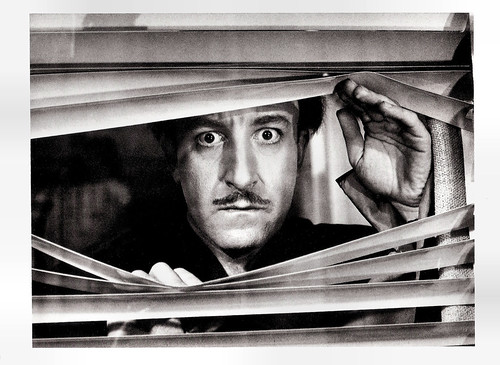
American postcard by Portfolio, NY, NY, no. P45. Photo: Louis Goldman, 1963.
Peter Sellers hit his stride in the early 1960s with three of his most famous roles. Stanley Kubrick asked him to play the role of the mentally unbalanced TV writer Clare Quilty in Lolita (Stanley Kubrick, 1962), opposite Sue Lyon, James Mason and Shelley Winters.
Sellers introduced audiences to the world’s most bumbling detective, French Inspector Jacques Clouseau, in Blake Edwards’s The Pink Panther (1963). The film proved to be a huge success, and it was quickly followed by the sequel A Shot in the Dark (Blake Edwards, 1964) again with Herbert Lom as Commissioner Dreyfus and Burt Kwouk as Cato.
Andrew Spicer in The Encyclopedia of British Cinema: “In Clouseau, Sellers combined his vocal ingenuity and skill as a slapstick comedian, yet always retained an essential humanity through the inspector's indefatigable dignity in the face of a hostile universe.”
In Kubricks’s cold war satire Dr. Strangelove or: How I Learned to Stop Worrying and Love the Bomb (Stanley Kubrick, 1964), Sellers once again showed his ability to tackle multiple characters the well-meaning US President Merkin Muffley, unflappable RAF Group Captain Lionel Mandrake and the nightmarish Dr. Strangelove himself, the government's adviser on nuclear warfare, who is unable to control his own body. His black gloved hand always tries to make a Nazi salute, expressing an ineradicable desire to dominate and destroy.
Kubrick later commented that the idea of having Sellers in so many of the film's key roles was that "everywhere you turn there is some version of Peter Sellers holding the fate of the world in his hands".
In 1964, Sellers had his first heart attack. He was reportedly clinically dead for two and a half minutes before being revived. This incident marked the beginning of his heart troubles, and he later had a pacemaker installed to help manage his heartbeat. Making a full recovery, Sellers continued to work in the cinema.
What's New Pussycat (Clive Donner, 1965) with Peter O'Toole and Romy Schneider, was another big hit, but a combination of his ego and insecurity made Sellers difficult to work with. When the James Bond spoof, Casino Royale (Ken Hughes, John Huston, Joseph McGrath, Robert Parrish, 1967) ran over budget and was unable to recoup its costs despite an otherwise healthy box-office take, Sellers received some of the blame. His films of the late 1960s and early 1970s had some decidedly mixed results.
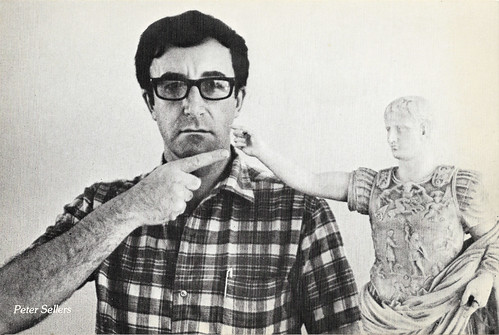
American postcard by Harlequin Enterprises Ltd., no. 151. Photo: Roddy McDowall. Caption: Peter Sellers, Hollywood, 1967.
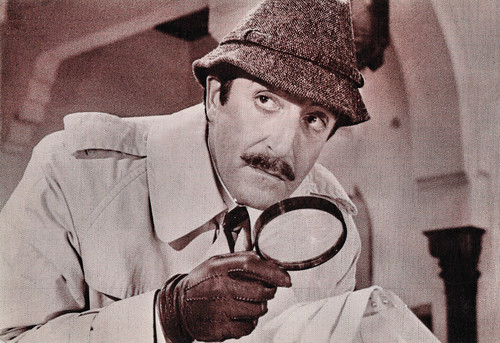
American postcard in The Ludlow Collection series by Classico San Francisco, no. 136-239. Photo: Peter Sellers as Inspector Jacques Clouseau in The Return of the Pink Panther (Blake Edwards, 1975).
It was Inspector Clouseau who gave Peter Sellers a boost at the box office with The Return of the Pink Panther (Blake Edwards, 1975) with Christopher Plummer and Catherine Schell. This hit spawned two more Pink Panther films, The Pink Panther Strikes Again (Blake Edwards, 1976), and Revenge of the Pink Panther (Blake Edwards, 1978).
Sellers earned raves for his subtle, understated turn as the simple gardener Chance who becomes an unlikely trusted adviser to a powerful businessman and an insider in Washington politics in Being There (Hal Asby, 1979), a film adaptation of Jerzy Kosinski's novel. His character spouts ideas and comments based on his years of television-watching, which are confused by others as words of wisdom. Sellers earned a Golden Globe Award and an Academy Award nomination for his performance.
After making this remarkable black comedy, Sellers’s career seemed to be on an upswing. But he never lived to realise this new wave of potential. His last film was The Fiendish Plot of Dr. Fu Manchu (Piers Haggard, 1980), a comedic re-imagining of the eponymous adventure novels by Sax Rohmer; Sellers played both police inspector Nayland Smith and Fu Manchu, alongside Helen Mirren and David Tomlinson. The film, completed just a few months before his death, proved to be another box office flop.
Peter Sellers died in a London hospital in 1980, after suffering another heart attack. Sellers was only 54. In his personal life, Sellers struggled with depression and insecurities. Wikipedia: “An enigmatic figure, he often claimed to have no identity outside the roles that he played. His behaviour was often erratic and compulsive, and he frequently clashed with his directors and co-stars, especially in the mid-1970s when his physical and mental health, together with his alcohol and drug problems, were at their worst.”
Sellers was married four times. He was survived by his fourth wife Lynne Frederick, and three children from his previous marriages. His son Michael and daughter Sarah came from his first marriage to Anne Howe and daughter Victoria came from his second marriage to actress Britt Ekland. He was also briefly married to Miranda Quarry from 1970 to 1974. Sellers was portrayed by Geoffrey Rush in the biopic The Life and Death of Peter Sellers (Stephen Hopkins, 2004).
Trailer The Mouse That Roared (1959). Source: CONELRAD6401240 (YouTube).
Trailer The Pink Panther (1964). Source: Bag Log (YouTube).
Trailer The Party (1968). Source: Movieclips Trailer Vault (YouTube).
Trailer Being There (1979). Source: George Botanos (YouTube).
Sources: Andrew Spicer (The Encyclopedia of British Cinema), Ashley G. Mackinnon (IMDb), Biography.com, Wikipedia and IMDb.

Spanish postcard by Raker no. 1132, 1965.

American postcard by Coral-Lee, Rancho Cordova, no. CL/Personality # 95. Photo: Dianne Schroeder / Sygma, 1979. Publicity still for Being There (Hal Ashby, 1979).
Absurd skits and bits
Richard Henry Sellers was born in 1925 in Southsea, a suburb of Portsmouth, England. He was literally born into show business. His parents, William 'Bill' Sellers and Agnes Doreen 'Peg' née Marks, were vaudeville performers in an acting company run by his grandmother, and Peter arrived while they were appearing in Southsea. Although christened Richard Henry, his parents called him Peter, after his elder stillborn brother.
Peter made his stage debut at the Kings Theatre, Southsea, when he was two weeks old. Sellers remained an only child. He began accompanying his parents in a variety act that toured the provincial theatres, causing much upheaval and unhappiness in the young Sellers' life. Sellers studied dance as a child before attending St. Aloysius’ Boarding and Day School for Boys.
As a teenager, Sellers learned to play the drums and played with jazz bands. At the age of 18, he entered the Royal Air Force during World War II. There he became part of a group of entertainers who performed for the troops. Sellers played his drums and did dead-on impersonations of some of the officers.
After the war, Sellers struggled to launch his comic career for several years. After several previous attempts, he managed to land work with the British Broadcasting Corporation (BBC) by winning over radio producer Roy Speer during a phone conversation. His spot-on impersonations helped to make him a beloved radio comedian.
In 1951, Sellers joined fellow comics Spike Milligan, Harry Secombe and Michael Bentine for The Goon Show. The program proved to be hugely popular with listeners who tuned in to hear their absurd skits and bits. The success of The Goon Show helped Sellers break into films.
In 1951 the Goons made their feature film debut in Penny Points to Paradise (Anthony Young, 1951). Sellers and Milligan then penned the script to the short Let's Go Crazy (Alan Cullimore, 1951), the earliest film to showcase Sellers's ability to portray a series of different characters within the same film, and he made another appearance opposite his Goons co-stars in the flop, Down Among the Z Men (Maclean Rogers, 1952).
In 1954, Sellers was cast opposite Sid James, Donald Pleasence and Eric Sykes in the comedy Orders Are Orders (David Paltenghi, 1955). Then he landed a part as one of the oddball criminals in the classic Ealing comedy The Ladykillers (Alexander Mackendrick, 1955) with Alec Guinness. The Ladykillers was a success in both Britain and the US, and the film was nominated for an Academy Award for Best Original Screenplay.
Sellers starred with David Tomlinson and Wilfrid Hyde-White as a chief petty officer in Up the Creek (Val Guest, 1958). In 1959, his career really took off with the satire I’m All Right, Jack (John and Roy Boulting, 1959). For his part as Fred Kite, the dogmatic communist union man, he won the BAFTA Award for Best Actor in a Leading Role. In The Mouse That Roared (Jack Arnold, 1959) with Jean Seberg, Sellers played three characters: the elderly Grand Duchess, the ambitious Prime Minister and the innocent and clumsy farm boy selected to lead an invasion of the United States. This box office hit helped to introduce Sellers to the American audiences.
In 1959 he was also nominated for an Academy Award for the eleven-minute short The Running Jumping & Standing Still Film (Richard Lester, Peter Sellers, 1959). Sellers portrayed an Indian doctor, Dr Ahmed el Kabir opposite Sophia Loren in the romantic comedy The Millionairess (Anthony Asquith, 1960) based on the George Bernard Shaw play. The Goon Show ended its run in 1960, but the program proved to be a strong influence on British comedy. It paved the way for such future comedy shows as Monty Python's Flying Circus.

Vintage postcard.

American postcard by Portfolio, NY, NY, no. P45. Photo: Louis Goldman, 1963.
The world’s most bumbling detective
Peter Sellers hit his stride in the early 1960s with three of his most famous roles. Stanley Kubrick asked him to play the role of the mentally unbalanced TV writer Clare Quilty in Lolita (Stanley Kubrick, 1962), opposite Sue Lyon, James Mason and Shelley Winters.
Sellers introduced audiences to the world’s most bumbling detective, French Inspector Jacques Clouseau, in Blake Edwards’s The Pink Panther (1963). The film proved to be a huge success, and it was quickly followed by the sequel A Shot in the Dark (Blake Edwards, 1964) again with Herbert Lom as Commissioner Dreyfus and Burt Kwouk as Cato.
Andrew Spicer in The Encyclopedia of British Cinema: “In Clouseau, Sellers combined his vocal ingenuity and skill as a slapstick comedian, yet always retained an essential humanity through the inspector's indefatigable dignity in the face of a hostile universe.”
In Kubricks’s cold war satire Dr. Strangelove or: How I Learned to Stop Worrying and Love the Bomb (Stanley Kubrick, 1964), Sellers once again showed his ability to tackle multiple characters the well-meaning US President Merkin Muffley, unflappable RAF Group Captain Lionel Mandrake and the nightmarish Dr. Strangelove himself, the government's adviser on nuclear warfare, who is unable to control his own body. His black gloved hand always tries to make a Nazi salute, expressing an ineradicable desire to dominate and destroy.
Kubrick later commented that the idea of having Sellers in so many of the film's key roles was that "everywhere you turn there is some version of Peter Sellers holding the fate of the world in his hands".
In 1964, Sellers had his first heart attack. He was reportedly clinically dead for two and a half minutes before being revived. This incident marked the beginning of his heart troubles, and he later had a pacemaker installed to help manage his heartbeat. Making a full recovery, Sellers continued to work in the cinema.
What's New Pussycat (Clive Donner, 1965) with Peter O'Toole and Romy Schneider, was another big hit, but a combination of his ego and insecurity made Sellers difficult to work with. When the James Bond spoof, Casino Royale (Ken Hughes, John Huston, Joseph McGrath, Robert Parrish, 1967) ran over budget and was unable to recoup its costs despite an otherwise healthy box-office take, Sellers received some of the blame. His films of the late 1960s and early 1970s had some decidedly mixed results.

American postcard by Harlequin Enterprises Ltd., no. 151. Photo: Roddy McDowall. Caption: Peter Sellers, Hollywood, 1967.

American postcard in The Ludlow Collection series by Classico San Francisco, no. 136-239. Photo: Peter Sellers as Inspector Jacques Clouseau in The Return of the Pink Panther (Blake Edwards, 1975).
Struggling with depression and insecurities
It was Inspector Clouseau who gave Peter Sellers a boost at the box office with The Return of the Pink Panther (Blake Edwards, 1975) with Christopher Plummer and Catherine Schell. This hit spawned two more Pink Panther films, The Pink Panther Strikes Again (Blake Edwards, 1976), and Revenge of the Pink Panther (Blake Edwards, 1978).
Sellers earned raves for his subtle, understated turn as the simple gardener Chance who becomes an unlikely trusted adviser to a powerful businessman and an insider in Washington politics in Being There (Hal Asby, 1979), a film adaptation of Jerzy Kosinski's novel. His character spouts ideas and comments based on his years of television-watching, which are confused by others as words of wisdom. Sellers earned a Golden Globe Award and an Academy Award nomination for his performance.
After making this remarkable black comedy, Sellers’s career seemed to be on an upswing. But he never lived to realise this new wave of potential. His last film was The Fiendish Plot of Dr. Fu Manchu (Piers Haggard, 1980), a comedic re-imagining of the eponymous adventure novels by Sax Rohmer; Sellers played both police inspector Nayland Smith and Fu Manchu, alongside Helen Mirren and David Tomlinson. The film, completed just a few months before his death, proved to be another box office flop.
Peter Sellers died in a London hospital in 1980, after suffering another heart attack. Sellers was only 54. In his personal life, Sellers struggled with depression and insecurities. Wikipedia: “An enigmatic figure, he often claimed to have no identity outside the roles that he played. His behaviour was often erratic and compulsive, and he frequently clashed with his directors and co-stars, especially in the mid-1970s when his physical and mental health, together with his alcohol and drug problems, were at their worst.”
Sellers was married four times. He was survived by his fourth wife Lynne Frederick, and three children from his previous marriages. His son Michael and daughter Sarah came from his first marriage to Anne Howe and daughter Victoria came from his second marriage to actress Britt Ekland. He was also briefly married to Miranda Quarry from 1970 to 1974. Sellers was portrayed by Geoffrey Rush in the biopic The Life and Death of Peter Sellers (Stephen Hopkins, 2004).
Trailer The Mouse That Roared (1959). Source: CONELRAD6401240 (YouTube).
Trailer The Pink Panther (1964). Source: Bag Log (YouTube).
Trailer The Party (1968). Source: Movieclips Trailer Vault (YouTube).
Trailer Being There (1979). Source: George Botanos (YouTube).
Sources: Andrew Spicer (The Encyclopedia of British Cinema), Ashley G. Mackinnon (IMDb), Biography.com, Wikipedia and IMDb.
No comments:
Post a Comment